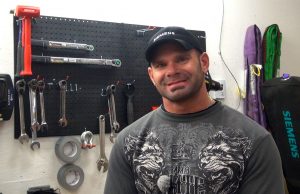By David Dodge & Dylan Thompson
It’s late winter in rural Saskatchewan. The highways are pretty quiet, aside from the small flocks of horned larks, playing Chicken with highway traffic.
It was hard not to notice the lack of snow in the western half of southern Saskatchewan as the Aspen Parkland turns into the prairie of the south. After many uneventful hours of driving a few white wind turbines start to appear on the predawn horizon as I head east from Swift Current.
I’m just south of Morse, Saskatchewan, a town of a few hundred people, two hours west of Regina along the Trans Canada highway. I’m here to visit one of the province’s newest wind farms.
Southern Saskatchewan, like Alberta have some of the best solar and wind resources in all of Canada. Well, if you really want to split hairs, Alberta is slightly better for wind and Saskatchewan is slightly better for solar energy production.
Up until recently, both provinces were rivals for having the dirtiest electricity production in the country. In 2014 Saskatchewan got 73 per cent of its electricity from fossil fuel sources, primarily coal (44 per cent) and natural gas (29 per cent). Saskatchewan also has some hydro (20 per cent) and wind (3 per cent).
So it was somewhat of a surprise when, in November, just before the climate change meetings in Paris, Premier Brad Wall announced his prairie province was going to get 50 per cent of its electricity from renewable sources by 2030.
According to scenarios from the premier and Saskpower, the province’s sole utility provider, a lynchpin of this plan is the rapid growth of wind power along with some solar and biomass.

Last November Premier Brad Wall of Saskatchewan announced his province would get 50 per cent of its electricity from renewable energy, mostly wind, hydro and solar. Photo David Dodge, GreenEnergyFutures.ca
Morse Wind Farm
Turning from the paved highways onto a gravel road, I pull up to a non-descript warehouse and park next to a truck with an Algonquin Power decal on it. Algonquin Power is based in Oakville, Ontario. They are the company that installed and maintains this wind farm as well as many other wind, hydroelectric, solar, and thermal projects around Canada and the U.S.
Barry Titchkosky comes outside to meet me. He’s the manager of the Morse wind farm and another farm in Manitoba. He offers me a ride in his truck to see the Morse turbines and we get to talking about the state of Saskatchewan’s wind.
“We know that Saskatchewan is a good market, with their government programs and looking for 50 per cent wind by 2030 that’s a good reason to come to Saskatchewan,” says Titchkosky.
“This project is 23 megawatts,” says Titchkosky. “We utilize Siemens turbines. They’re a new style turbine, new technology. They’re a gearless model with permanent magnets. There’s 10 in total. 2.3 megawatts each. That’s enough electricity to power about 8,500 homes.”
We pull back onto the paved highway and the turbines come back into view. Motioning towards them, Titchkosky continues: “These ones here are 80 meter towers, and then the blade is another 55 meters. So, that’d be 135 meters from the ground to the tip of the blade.”
That’s longer than a football field, it’s almost hard to comprehend even when you are standing right below one of them.
While this is a small project by today’s standards, Algonquin is building a larger 177 megawatt wind project just down the road in Chaplin, Saskatchewan. Currently Algonquin Power owns about 47 per cent of Saskatchewan’s existing and under-construction wind capacity of 428 megawatts.
How is the wind resource in Saskatchewan?
“Saskatchewan has a phenomenal wind regime,” says Titchkosky adding that the Morse Wind Farm will produce full power 50 per cent of the time.
Just how good is that? “Oh, that’s excellent. Our wind farm in Manitoba is 42 per cent. Here, we’re right around 50 per cent, … so it is a really good and a very consistent and non-turbulent type wind.”
The road less travelled

These charts from SaskPower show a scenario of renewable energy growing by 184% and and fossil fuel generation still growing by 10% to reach the 50% renewables generation capacity figure by 2030. This translates into significant growth in wind, some small growth in hydro and building some new biomass and solar. Photo SaskPower Flickr page
Getting Saskatchewan to 50 per cent renewable energy by 2030 is quite an ambitious goal.
“They’re asking for 1,600 more megawatts between 2019 to 2030, plus another 100 megawatts in 2016, so for a total of 1,700 megawatts,” says Titchkosky.
This is a pretty big change for Saskatchewan that has about 228 megawatts of wind in operation today.
Premier Wall has also signaled an intention to support solar energy. “What will be relatively new is the emphasis and focus on solar power,” Wall told Global news in November. “In the last number of years, I think there’s been pretty good advancements in the technology.”
Saskatchewan introduced a net metering solar program in 2007 that pays for up to 20 per cent of the capital costs of small (less than 100 kW) solar projects and pays going rates for excess energy produced.
But when it comes to a carbon tax Wall took a hard-line against a carbon tax a recent first minister’s summit in Canada, He eventually agreed to “carbon pricing mechanisms” but not a carbon tax or cap and trade system to cut greenhouse gas emissions.
Saskatchewan’s recent investments of $1.4 billion in carbon capture and storage aims to secure one million tonnes in emissions reductions, but isn’t performing as well as expected, which is raising questions about the feasibility the cost.
Green energy jobs

Diversification and job creation are watch words in Canada’s prairie provinces these days as Nathan Mathies will attest. The journeyman electricity relocated from Alberta’s oil patch to take a job servicing wind turbines for Siemen’s in southern Saskatchewan. “I’m very optimistic, as everything seems to be going green power in Canada,” says Mathies. Alberta and Saskatchewan have only taken small steps so far, but in the U.S. there were more than 73,000 wind jobs by the end of 2014. Photo David Dodge, GreenEnergyFutures.ca
After we return to Algonquin Power’s shop where I met Titchkosky, I’m introduced to one of Siemen’s recent hires, Nathan Mathies, a journeyman electrician who’s worked in Alberta’s oil and gas industry for 12 years.
Mathies received a tip that there might be a job in wind so he applied to Siemens and began a new career in the wind business.
“I’m very optimistic, as everything seems to be going green power in Canada,” says Mathies. He sees it as the way of the future for Alberta and Saskatchewan.
It’s just one job, but it could mean a lot more jobs as we’ve seen in the U.S. where by the end of 2015 there were 209,000 solar workers. According to the American Wind Energy Association there were 73,000 wind jobs by the end of 2014. How these numbers translate in Saskatchewan, or Canada will depend on what the provinces and federal government execute.
As for Nathan Mathies, the freshly minted wind worker in Morse, Saskatchewan: I asked him if he hopes to be poking his head out of the top of an 80 meter tall wind turbine anytime soon.
“You’ll see me poking out from the back because these towers don’t open up from the top, they’re direct drives,” says Mathies. “They’re the new technology of wind turbines, so we got the best of the best here at Saskatchewan.”






